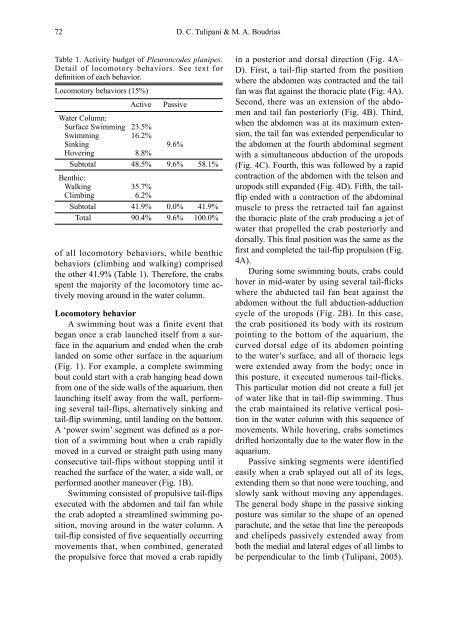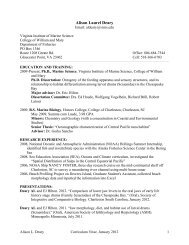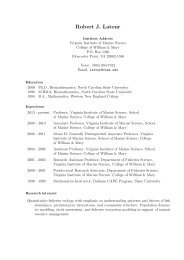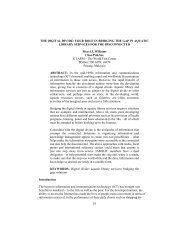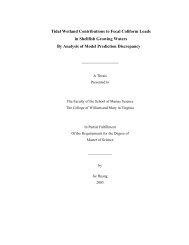Behaviors of the pelagic red crab Pleuroncodes planipes observed ...
Behaviors of the pelagic red crab Pleuroncodes planipes observed ...
Behaviors of the pelagic red crab Pleuroncodes planipes observed ...
You also want an ePaper? Increase the reach of your titles
YUMPU automatically turns print PDFs into web optimized ePapers that Google loves.
72 D. C. Tulipani & M. A. BoudriasTable 1. Activity budget <strong>of</strong> <strong>Pleuroncodes</strong> <strong>planipes</strong>.Detail <strong>of</strong> locomotory behaviors. See text fordefinition <strong>of</strong> each behavior.Locomotory behaviors (15%)Active PassiveWater Column:Surface Swimming 23.5%Swimming 16.2%Sinking 9.6%Hovering 8.8%Subtotal 48.5% 9.6% 58.1%Benthic:Walking 35.7%Climbing 6.2%Subtotal 41.9% 0.0% 41.9%Total 90.4% 9.6% 100.0%<strong>of</strong> all locomotory behaviors, while benthicbehaviors (climbing and walking) comprised<strong>the</strong> o<strong>the</strong>r 41.9% (Table 1).Therefore, <strong>the</strong> <strong>crab</strong>sspent <strong>the</strong> majority <strong>of</strong> <strong>the</strong> locomotory time activelymoving around in <strong>the</strong> water column.Locomotory behaviorA swimming bout was a finite event thatbegan once a <strong>crab</strong> launched itself from a surfacein <strong>the</strong> aquarium and ended when <strong>the</strong> <strong>crab</strong>landed on some o<strong>the</strong>r surface in <strong>the</strong> aquarium(Fig. 1). For example, a complete swimmingbout could start with a <strong>crab</strong> hanging head downfrom one <strong>of</strong> <strong>the</strong> side walls <strong>of</strong> <strong>the</strong> aquarium, <strong>the</strong>nlaunching itself away from <strong>the</strong> wall, performingseveral tail-flips, alternatively sinking andtail-flip swimming, until landing on <strong>the</strong> bottom.A ‘power swim’ segment was defined as a portion<strong>of</strong> a swimming bout when a <strong>crab</strong> rapidlymoved in a curved or straight path using manyconsecutive tail-flips without stopping until itreached <strong>the</strong> surface <strong>of</strong> <strong>the</strong> water, a side wall, orperformed ano<strong>the</strong>r maneuver (Fig. 1B).Swimming consisted <strong>of</strong> propulsive tail-flipsexecuted with <strong>the</strong> abdomen and tail fan while<strong>the</strong> <strong>crab</strong> adopted a streamlined swimming position,moving around in <strong>the</strong> water column. Atail-flip consisted <strong>of</strong> five sequentially occurringmovements that, when combined, generated<strong>the</strong> propulsive force that moved a <strong>crab</strong> rapidlyin a posterior and dorsal direction (Fig. 4A–D). First, a tail-flip started from <strong>the</strong> positionwhere <strong>the</strong> abdomen was contracted and <strong>the</strong> tailfan was flat against <strong>the</strong> thoracic plate (Fig. 4A).Second, <strong>the</strong>re was an extension <strong>of</strong> <strong>the</strong> abdomenand tail fan posteriorly (Fig. 4B). Third,when <strong>the</strong> abdomen was at its maximum extension,<strong>the</strong> tail fan was extended perpendicular to<strong>the</strong> abdomen at <strong>the</strong> fourth abdominal segmentwith a simultaneous abduction <strong>of</strong> <strong>the</strong> uropods(Fig. 4C). Fourth, this was followed by a rapidcontraction <strong>of</strong> <strong>the</strong> abdomen with <strong>the</strong> telson anduropods still expanded (Fig. 4D). Fifth, <strong>the</strong> tailflipended with a contraction <strong>of</strong> <strong>the</strong> abdominalmuscle to press <strong>the</strong> retracted tail fan against<strong>the</strong> thoracic plate <strong>of</strong> <strong>the</strong> <strong>crab</strong> producing a jet <strong>of</strong>water that propelled <strong>the</strong> <strong>crab</strong> posteriorly anddorsally. This final position was <strong>the</strong> same as <strong>the</strong>first and completed <strong>the</strong> tail-flip propulsion (Fig.4A).During some swimming bouts, <strong>crab</strong>s couldhover in mid-water by using several tail-flickswhere <strong>the</strong> abducted tail fan beat against <strong>the</strong>abdomen without <strong>the</strong> full abduction-adductioncycle <strong>of</strong> <strong>the</strong> uropods (Fig. 2B). In this case,<strong>the</strong> <strong>crab</strong> positioned its body with its rostrumpointing to <strong>the</strong> bottom <strong>of</strong> <strong>the</strong> aquarium, <strong>the</strong>curved dorsal edge <strong>of</strong> its abdomen pointingto <strong>the</strong> water’s surface, and all <strong>of</strong> thoracic legswere extended away from <strong>the</strong> body; once inthis posture, it executed numerous tail-flicks.This particular motion did not create a full jet<strong>of</strong> water like that in tail-flip swimming. Thus<strong>the</strong> <strong>crab</strong> maintained its relative vertical positionin <strong>the</strong> water column with this sequence <strong>of</strong>movements. While hovering, <strong>crab</strong>s sometimesdrifted horizontally due to <strong>the</strong> water flow in <strong>the</strong>aquarium.Passive sinking segments were identifiedeasily when a <strong>crab</strong> splayed out all <strong>of</strong> its legs,extending <strong>the</strong>m so that none were touching, andslowly sank without moving any appendages.The general body shape in <strong>the</strong> passive sinkingposture was similar to <strong>the</strong> shape <strong>of</strong> an openedparachute, and <strong>the</strong> setae that line <strong>the</strong> pereopodsand chelipeds passively extended away fromboth <strong>the</strong> medial and lateral edges <strong>of</strong> all limbs tobe perpendicular to <strong>the</strong> limb (Tulipani, 2005).


